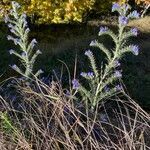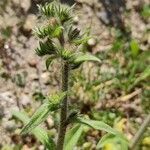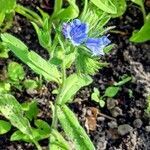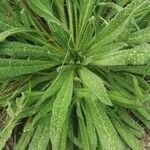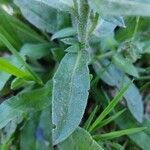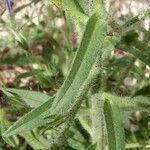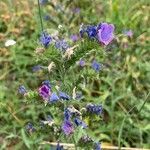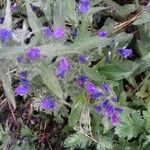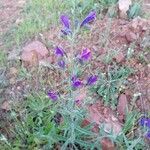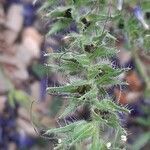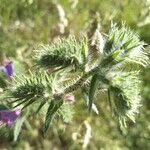Herbs biennial. Stems usually erect, to 1 m, usually much branched, spreading hirsute, densely short appressed pubescent. Basal and lower stem leaves linear-lanceolate, ca. 12 × 1.4 cm, long strigose, base attenuate; upper stem leaves sessile, lanceolate, smaller. Inflorescences long, narrow, many flowered; bracts narrowly lanceolate, 4-15 mm. Flowers somewhat crowded. Calyx 5-parted to base, hirsute outside; lobes lanceolate-linear, ca. 6 mm, to 1 cm in fruit. Corolla blue-purple, oblique-campanulate, ca. 1.2 cm, short appressed pubescent outside; lobes unequal, upper lobe larger. Filaments 1-1.2 cm; anthers oblong, ca. 0.5 mm. Style ca. 1.4 cm; stigma terminal. Nutlets ovoid, ca. 2.5 mm, tuberculate. 2n = 16, 32 (31, 33, 34).
Densely scabrid or hispid annual or biennial herb to c. 90 cm high but often much less. Basal lvs to c. 15 × 5 cm, linear-lanceolate, lanceolate, or lanceolate-elliptic; base attenuate and petiolate; apex acute; upper cauline lvs smaller, sessile, commonly linear or nearly so, rounded at base. Infl. simple or with several branches; branches becoming spike-like or paniculate. Calyx 5-8 mm long; lobes linear, < corolla tube. Corolla 12-18 mm long, pink in bud, becoming blue, rarely remaining completely pale pink and even more rarely white; upper lobes > lower. Stamens purplish pink, very rarely whitish, 4 long-exserted on filiform filaments, fifth included or slightly exserted. Nutlets c. 2 mm long, sharply angular.
Biennial or perennial herb, up to 1 m high. Stems erect or decumbent. Leaves subsessile or sessile; basal leaves attenuating into a short petiole (subsessile); blade linear to narrowly obovate or ovate, 50-260 x 10-30 mm, lateral veins not prominent; cauline leaves narrowly ovate. Flowers: in helicoid cymes; stamens with 4 long-exserted, 1 short, included; calyx lobes 6-8 mm long in fruit; corolla broadly funnel-shaped, 10-15 mm long, outer surface puberulous and with long, simple hairs on veins and margins, brilliant blue, fading to mauve; Nov.-Mar.
Biennial or perennial herb, up to 1 m high. Stems erect or decumbent. Leaves: basal leaves attenuating into a short petiole (subsessile), blade linear to narrowly obovate or ovate, 50-260 x 10-30 mm, lateral veins not prominent; cauline leaves narrowly ovate. Caly x: lobes 6-8 mm long in fruit. Corolla brilliant blue, fading to mauve, broadly funnel-shaped, ± 10-15 mm long, outer surface puberulous and with long, simple hairs on veins and margins. Stamens included, 4 long-exserted, 1 short. Flowering time Nov.-Mar.
Erect, taprooted biennial 3–8 dm, rough-hairy especially above; basal lvs ± oblanceolate, 6–25 cm (petiole included) × 0.5–3 cm, the cauline progressively smaller, becoming sessile; helicoid cymes numerous and often short, ± aggregated into a pyramidal or elongate, often virgate infl; cor bright blue (pink or white), 12–20 mm; 4 filaments long-exsert, the fifth barely or scarcely so; style hairy; 2n=16, 32. Native of s. Europe, now a common weed in waste places, roadsides, and meadows in our range. June–Oct.
A herb which grows over two years. It reaches to 45-60 cm tall and spreads to 45-60 cm wide. It is rough and hairy. It can have one or several stems. The flowers are 10-19 mm long. Four of the five stamens are longer than the remaining one. The flowers are violet. They are on branching spikes. The flowers are 18 mm across. The fruit are 4 nutlets.
Herb, 0.2-0.9 m high. Basal leaves shorter than 150 mm, elliptical to lanceolate, attenuate and petiolate at base; upper leaves narrowly lanceolate, sessile. Corolla 10-19 mm long, with 4 or 5 stamens exserted from corolla tube. Flowers blue to bluish violet.
